当前位置:网站首页>NIO知识汇总 收藏这一篇就够了!!!
NIO知识汇总 收藏这一篇就够了!!!
2022-08-03 05:25:00 【黄俊懿】
NIO知识汇总
NIO知识汇总
NIO与IO的区别
Java NIO(New IO)是从Java 1.4版本开始引入的一个新的IO API,可以替代标准的Java IO
API。NIO与原来的IO有同样的作用和目的,但是使用的方式完全不同,NIO支持面向缓冲区的、基于通道的IO操作。NIO将以更加高效的方式进行文件的读写操作。
| IO | NIO |
|---|---|
| 面向流(Stream Oriented) | 面向缓冲区(Buffer Oriented) |
| 阻塞IO(Blocking IO) | 非阻塞IO(Non Blocking IO) |
| (无) | 选择器(Selectors) |
通道和缓存区
Java NIO系统的核心在于:通道(Channel)和缓冲区(Buffer)。通道表示打开到 IO设备(例如:文件、套接字)的连接。若需要使用 NIO 系统,需要获取用于连接 IO设备的通道以及用于容纳数据的缓冲区。然后操作缓冲区,对数据进行处理
缓冲区
Buffer 中的重要概念:
- 容量 (capacity) :表示 Buffer 最大数据容量,缓冲区容量不能为负,并且创建后不能更改。
- 限制 (limit) :第一个不应该读取或写入的数据的索引,即位于 limit 后的数据不可读写。缓冲区的限制不能为负,并且不能大于其容量。
- 位置 (position): :下一个要读取或写入的数据的索引。缓冲区的位置不能为负,并且不能大于其限制
- 标记 (mark) 与重置 (reset) :标记是一个索引,通过 Buffer 中的 mark() 方法指定 Buffer 中一个特定的 position,之后可以通过调用 reset() 方法恢复到这个 position.
标记 、 位置 、 限制 、 容量遵守以下不变式: 0 <= mark <= position <= limit <= capacity
缓冲区的基本属性
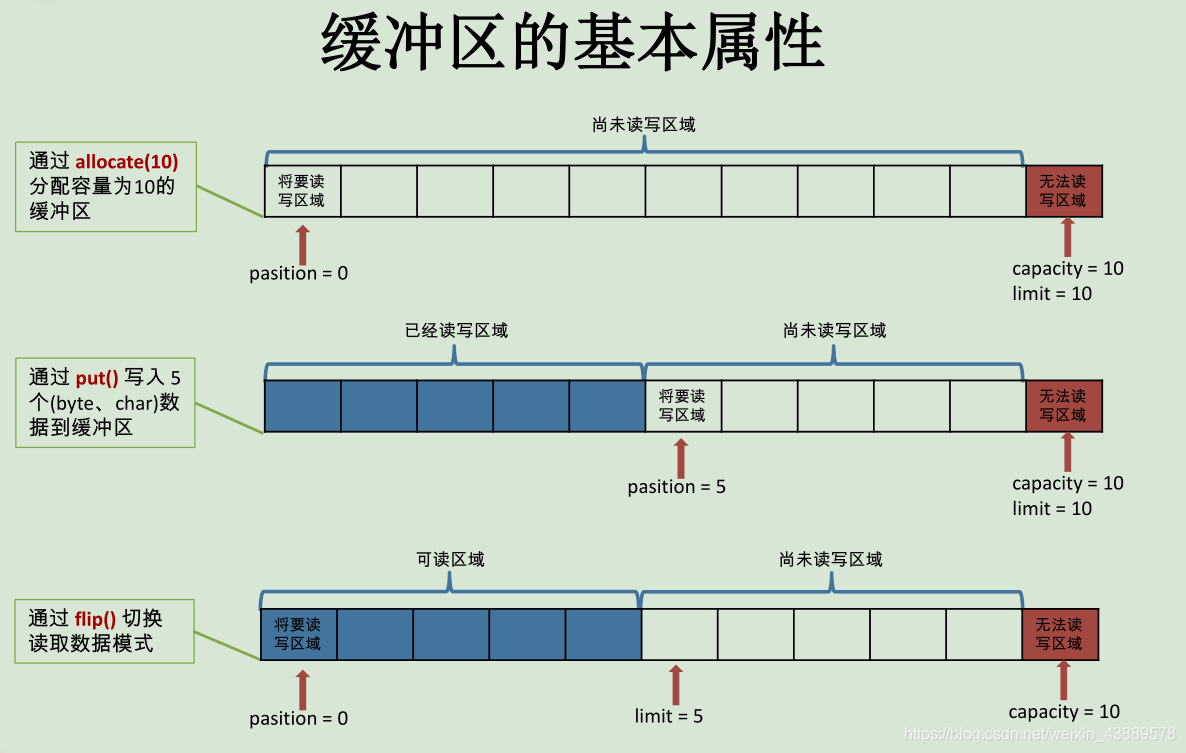
Buffer 的常用方法
| 方 法 | 描述 |
|---|---|
| Buffer clear() | 清空缓冲区并返回对缓冲区的引用 |
| Buffer flip() | 将缓冲区的界限设置为当前位置,并将当前位置重置为 0 |
| int capacity() | 返回缓冲区容量大小 |
| boolean hasRemaining() | 判断缓冲区中是否还有元素 |
| int limit() | 返回 Buffer 的界限(limit) 的位置 |
| Buffer limit(int n) | 将设置缓冲区界限为 n, 并返回一个具有新 limit 的缓冲区对象 |
| Buffer mark() | 对缓冲区设置标记 |
| int position() | 返回缓冲区的当前位置 position |
| Buffer position(int n) | 将设置缓冲区的当前位置为 n , 并返回修改后的 Buffer 对象 |
| int remaining() | 返回 position 和 limit 之间的元素个数 |
| Buffer reset() | 将位置 position 转到以前设置的 mark 所在的位置 |
| Buffer rewind() | 将位置 position 转到以前设置的 mark 所在的位置 |
缓冲区的数据操作
Buffer 所有子类提供了两个用于数据操作的方法:get()与 put() 方法
获取 Buffer 中的数据
- get() :读取单个字节
- get(byte[] dst):批量读取多个字节到 dst 中
- get(int index):读取指定索引位置的字节(不会移动 position)
放到 入数据到 Buffer 中
- put(byte b):将给定单个字节写入缓冲区的当前位置
- put(byte[] src):将 src 中的字节写入缓冲区的当前位置
- put(int index, byte b):将指定字节写入缓冲区的索引位置(不会移动 position)
缓冲区的类型
根据数据类型不同(boolean 除外),提供了相应类型的缓冲区:
- ByteBuffer
- CharBuffer
- ShortBuffer
- IntBuffer
- LongBuffer
- FloatBuffer
- DoubleBuffer
package com.nio.demo;
import java.nio.Buffer;
import java.nio.ByteBuffer;
public class _01BufferTest {
public static void main(String[] args) {
String msg = "hello world";
/*分配1024字节大小的byte缓冲区,缓冲区就是数组*/
ByteBuffer buffer = ByteBuffer.allocate(1024);
/*往缓冲区写入数据*/
buffer.put(msg.getBytes());
System.out.println("---------------------put-------------------");
System.out.println("capacity---"+buffer.capacity()); // 1024
System.out.println("position---"+buffer.position()); // 11
System.out.println("limit---"+buffer.limit()); // 1024
/*缓冲区切换到读模式*/
buffer.flip();
System.out.println("---------------------flip-------------------");
System.out.println("capacity---"+buffer.capacity()); // 1024
System.out.println("position---"+buffer.position()); // 0
System.out.println("limit---"+buffer.limit()); // 11
byte[] bytes = new byte[buffer.limit()];
/*从缓冲区中读取数据*/
buffer.get(bytes);
System.out.println("---------------------get-------------------");
System.out.println("data---"+new String(bytes)); // hello world
System.out.println("capacity---"+buffer.capacity()); // 1024
System.out.println("position---"+buffer.position()); // 11
System.out.println("limit---"+buffer.limit()); // 11
/*重新度数据*/
buffer.rewind();
System.out.println("---------------------rewind-------------------");
System.out.println("capacity---"+buffer.capacity()); // 1024
System.out.println("position---"+buffer.position()); // 0
System.out.println("limit---"+buffer.limit()); // 11
bytes = new byte[buffer.limit()];
/*从指定位置开始,读取指定长度数据*/
buffer.get(bytes, 0, 5);
System.out.println("---------------------get1-------------------");
System.out.println("data---"+new String(bytes)); // hello
System.out.println("capacity---"+buffer.capacity()); // 1024
System.out.println("position---"+buffer.position()); // 5
System.out.println("limit---"+buffer.limit()); // 11
/*标签当前读取到的位置*/
buffer.mark();
System.out.println("---------------------mark-------------------");
System.out.println("capacity---"+buffer.capacity()); // 1024
System.out.println("position---"+buffer.position()); // 5
System.out.println("limit---"+buffer.limit()); // 11
buffer.get(bytes, 0, 5);
System.out.println("data---"+new String(bytes)); // world
/*恢复到上一次mark的位置*/
buffer.reset();
System.out.println("---------------------reset-------------------");
System.out.println("capacity---"+buffer.capacity()); // 1024
System.out.println("position---"+buffer.position()); // 5
System.out.println("limit---"+buffer.limit()); // 11
/*清空缓冲区. 但是缓冲区中的数据依然存在,但是处于“被遗忘”状态*/
buffer.clear();
System.out.println("---------------------clear-------------------");
System.out.println("capacity---"+buffer.capacity()); // 1024
System.out.println("position---"+buffer.position()); // 0
System.out.println("limit---"+buffer.limit()); // 1024
System.out.println("clear data---"+(char)buffer.get()); // h
}
}
直接缓冲区与非直接缓冲区
- 非直接缓冲区:通过 allocate() 方法分配缓冲区,将缓冲区建立在 JVM 的内存中
- 直接缓冲区:通过 allocateDirect() 方法分配直接缓冲区,将缓冲区建立在物理内存中。可以提高效率
- 字节缓冲区要么是直接的,要么是非直接的。如果为直接字节缓冲区,则 Java 虚拟机会尽最大努力直接在此缓冲区上执行本机 I/O 操作。也就是说,在每次调用基础操作系统的一个本机 I/O 操作之前(或之后),虚拟机都会尽量避免将缓冲区的内容复制到中间缓冲区中(或从中间缓冲区中复制内容)。
- 直接字节缓冲区可以通过调用此类的 allocateDirect() 工厂方法 来创建。此方法返回的 缓冲区进行分配和取消分配所需成本通常高于非直接缓冲区 。直接缓冲区的内容可以驻留在常规的垃圾回收堆之外,因此,它们对应用程序的内存需求量造成的影响可能并不明显。所以,建议将直接缓冲区主要分配给那些易受基础系统的本机 I/O 操作影响的大型、持久的缓冲区。一般情况下,最好仅在直接缓冲区能在程序性能方面带来明显好处时分配它们。
- 直接字节缓冲区还可以通过FileChannel 的 map() 方法 将文件区域直接映射到内存中来创建 。该方法返回MappedByteBuffer 。Java 平台的实现有助于通过 JNI 从本机代码创建直接字节缓冲区。如果以上这些缓冲区中的某个缓冲区实例指的是不可访问的内存区域,则试图访问该区域不会更改该缓冲区的内容,并且将会在访问期间或稍后的某个时间导致抛出不确定的异常。
- 字节缓冲区是直接缓冲区还是非直接缓冲区可通过调用其 isDirect() 方法来确定。提供此方法是为了能够在性能关键型代码中执行显式缓冲区管理 。
非直接缓冲区
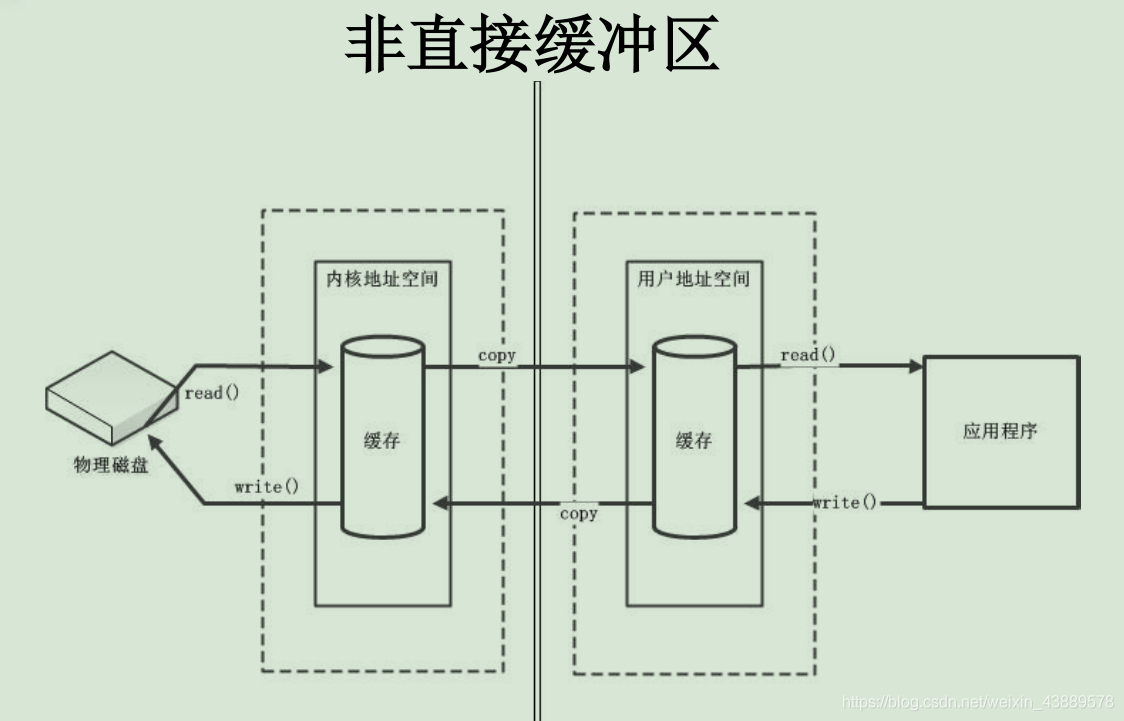
直接缓冲区
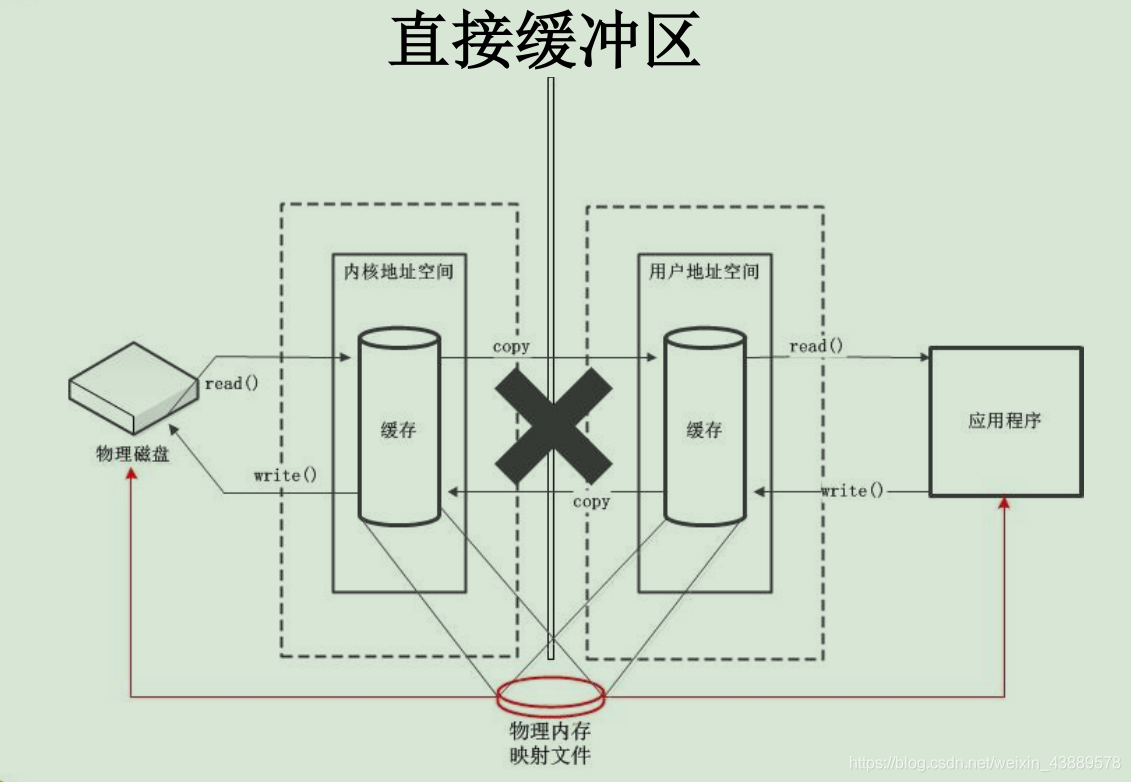
package com.nio.demo;
import java.nio.Buffer;
import java.nio.ByteBuffer;
public class _02BufferTest {
public static void main(String[] args) {
ByteBuffer byteBuffer = ByteBuffer.allocateDirect(1024);
System.out.println(byteBuffer.isDirect()); // true
}
}
通道(Channel)
通道(Channel):用于源节点与目标节点的连接。在 Java NIO 中负责缓冲区中数据的传输。Channel
本身不存储数据,因此需要配合缓冲区进行传输。
通道的主要实现类
java.nio.channels.Channel 接口:
- FileChannel 用于读取、写入、映射和操作文件的通道。
- DatagramChannel 通过 UDP 读写网络中的数据通道。
- SocketChannel 通过 TCP 读写网络中的数据。
- ServerSocketChannel 可以监听新进来的 TCP 连接,对每一个新进来的连接都会创建一个 SocketChannel。
获取通道
- Java 针对支持通道的类提供了 getChannel() 方法
- 本地 IO:
- FileInputStream/FileOutputStream
- RandomAccessFile
- 网络IO:
- Socket
- ServerSocket
- DatagramSocket
- 在 JDK 1.7 中的 NIO.2 针对各个通道提供了静态方法 open()
- 在 JDK 1.7 中的 NIO.2 的 Files 工具类的 newByteChannel()
//利用通道完成文件的复制(非直接缓冲区)
@Test
public void test1(){
//10874-10953
long start = System.currentTimeMillis();
FileInputStream fis = null;
FileOutputStream fos = null;
//①获取通道
FileChannel inChannel = null;
FileChannel outChannel = null;
try {
fis = new FileInputStream("d:/1.mkv");
fos = new FileOutputStream("d:/2.mkv");
inChannel = fis.getChannel();
outChannel = fos.getChannel();
//②分配指定大小的缓冲区
ByteBuffer buf = ByteBuffer.allocate(1024);
//③将通道中的数据存入缓冲区中
while(inChannel.read(buf) != -1){
buf.flip(); //切换读取数据的模式
//④将缓冲区中的数据写入通道中
outChannel.write(buf);
buf.clear(); //清空缓冲区
}
} catch (IOException e) {
e.printStackTrace();
} finally {
if(outChannel != null){
try {
outChannel.close();
} catch (IOException e) {
e.printStackTrace();
}
}
if(inChannel != null){
try {
inChannel.close();
} catch (IOException e) {
e.printStackTrace();
}
}
if(fos != null){
try {
fos.close();
} catch (IOException e) {
e.printStackTrace();
}
}
if(fis != null){
try {
fis.close();
} catch (IOException e) {
e.printStackTrace();
}
}
}
long end = System.currentTimeMillis();
System.out.println("耗费时间为:" + (end - start));
}
//使用直接缓冲区完成文件的复制(内存映射文件)
@Test
public void test2() throws IOException{
//2127-1902-1777
long start = System.currentTimeMillis();
FileChannel inChannel = FileChannel.open(Paths.get("d:/1.mkv"), StandardOpenOption.READ);
FileChannel outChannel = FileChannel.open(Paths.get("d:/2.mkv"), StandardOpenOption.WRITE, StandardOpenOption.READ, StandardOpenOption.CREATE);
//内存映射文件
MappedByteBuffer inMappedBuf = inChannel.map(MapMode.READ_ONLY, 0, inChannel.size());
MappedByteBuffer outMappedBuf = outChannel.map(MapMode.READ_WRITE, 0, inChannel.size());
//直接对缓冲区进行数据的读写操作
byte[] dst = new byte[inMappedBuf.limit()];
inMappedBuf.get(dst);
outMappedBuf.put(dst);
inChannel.close();
outChannel.close();
long end = System.currentTimeMillis();
System.out.println("耗费时间为:" + (end - start));
}
通道之间的数据传输
- transferFrom()
- transferTo()
//通道之间的数据传输(直接缓冲区)
@Test
public void test3() throws IOException{
FileChannel inChannel = FileChannel.open(Paths.get("d:/1.mkv"), StandardOpenOption.READ);
FileChannel outChannel = FileChannel.open(Paths.get("d:/2.mkv"), StandardOpenOption.WRITE, StandardOpenOption.READ, StandardOpenOption.CREATE);
// inChannel.transferTo(0, inChannel.size(), outChannel);
outChannel.transferFrom(inChannel, 0, inChannel.size());
inChannel.close();
outChannel.close();
}
分散(Scatter)与聚集(Gather)
- 分散读取(Scattering Reads):将通道中的数据分散到多个缓冲区中
- 聚集写入(Gathering Writes):将多个缓冲区中的数据聚集到通道中
//分散和聚集
@Test
public void test4() throws IOException{
RandomAccessFile raf1 = new RandomAccessFile("1.txt", "rw");
//1. 获取通道
FileChannel channel1 = raf1.getChannel();
//2. 分配指定大小的缓冲区
ByteBuffer buf1 = ByteBuffer.allocate(100);
ByteBuffer buf2 = ByteBuffer.allocate(1024);
//3. 分散读取
ByteBuffer[] bufs = {
buf1, buf2};
channel1.read(bufs);
for (ByteBuffer byteBuffer : bufs) {
byteBuffer.flip();
}
System.out.println(new String(bufs[0].array(), 0, bufs[0].limit()));
System.out.println("-----------------");
System.out.println(new String(bufs[1].array(), 0, bufs[1].limit()));
//4. 聚集写入
RandomAccessFile raf2 = new RandomAccessFile("2.txt", "rw");
FileChannel channel2 = raf2.getChannel();
channel2.write(bufs);
}
FileChannel 的常用方法
| 方法 | 描述 |
|---|---|
| int read(ByteBuffer dst) | 从 Channel 到 中读取数据到 |
| long read(ByteBuffer[] dsts) | 将 Channel 中的数据“分散”到ByteBuffer[] |
| int write(ByteBuffer src) | 将 ByteBuffer 中的数据写入到 Channel |
| long write(ByteBuffer[] srcs) | 将 ByteBuffer[] 中的数据“聚集”到 Channel |
| long position() | 返回此通道的文件位置 |
| FileChannel position(long p) | 设置此通道的文件位置 |
| long size() | 返回此通道的文件的当前大小 |
| FileChannel truncate(long s) | 将此通道的文件截取为给定大小 |
| void force(boolean metaData) | 强制将所有对此通道的文件更新写入到存储设备中 |
字符集 (Charset)
- 编码:字符串 -> 字节数组
- 解码:字节数组 -> 字符串
@Test
public void test5(){
Map<String, Charset> map = Charset.availableCharsets();
Set<Entry<String, Charset>> set = map.entrySet();
for (Entry<String, Charset> entry : set) {
System.out.println(entry.getKey() + "=" + entry.getValue());
}
}
//字符集
@Test
public void test6() throws IOException{
Charset cs1 = Charset.forName("GBK");
//获取编码器
CharsetEncoder ce = cs1.newEncoder();
//获取解码器
CharsetDecoder cd = cs1.newDecoder();
CharBuffer cBuf = CharBuffer.allocate(1024);
cBuf.put("hello world");
cBuf.flip();
//编码
ByteBuffer bBuf = ce.encode(cBuf);
for (int i = 0; i < 12; i++) {
System.out.println(bBuf.get());
}
//解码
bBuf.flip();
CharBuffer cBuf2 = cd.decode(bBuf);
System.out.println(cBuf2.toString());
System.out.println("------------------------------------------------------");
Charset cs2 = Charset.forName("GBK");
bBuf.flip();
CharBuffer cBuf3 = cs2.decode(bBuf);
System.out.println(cBuf3.toString());
}
阻塞与非阻塞
传统的 IO 流都是阻塞式的。也就是说,当一个线程调用 read() 或 write()时,该线程被阻塞,直到有一些数据被读取或写入,该线程在此期间不 能执行其他任务。因此,在完成网络通信进行 IO 操作时,由于线程会阻塞,所以服务器端必须为每个客户端都提供一个独立的线程进行处理, 当服务器端需要处理大量客户端时,性能急剧下降。
Java NIO 是非阻塞模式的。当线程从某通道进行读写数据时,若没有数 据可用时,该线程可以进行其他任务。线程通常将非阻塞 IO 的空闲时间用于在其他通道上执行 IO 操作,所以单独的线程可以管理多个输入 和输出通道。因此,NIO 可以让服务器端使用一个或有限几个线程来同时处理连接到服务器端的所有客户端。
使用 NIO 完成网络通信
使用 NIO 完成网络通信的三个核心
- 通道(Channel)
- 缓冲区(Buffer)
- 选择器(Selector)
通道(Channel)
负责连接
- java.nio.channels.Channel 接口:
- SelectableChannel
- SocketChannel
- ServerSocketChannel
- DatagramChannel
- Pipe.SinkChannel
- Pipe.SourceChannel
缓冲区(Buffer)
负责数据的存取
选择器(Selector)
是 SelectableChannel 的多路复用器。用于监控 SelectableChannel 的 IO 状况
选择器
选择器(Selector) 是 SelectableChannle 对象的多路复用器,Selector 可以同时监控多个 SelectableChannel 的 IO 状况,也就是说,利用 Selector可使一个单独的线程管理多个 Channel。Selector 是非阻塞 IO 的核心。
选择 器(Selector )的应用
- 创建 Selector :通过调用 Selector.open() 方法创建一个 Selector。
- 向选择器注册通道:SelectableChannel.register(Selector sel, int ops)
- 当调用 register(Selector sel, int ops) 将通道注册选择器时,选择器对通道的监听事件,需要通过第二个参数 ops 指定。
- 可以监听的事件类型(用 可使用 SelectionKey 的四个常量 表示):
- 读 : SelectionKey.OP_READ (1)
- 写 : SelectionKey.OP_WRITE (4)
- 连接 : SelectionKey.OP_CONNECT (8)
- 接收 : SelectionKey.OP_ACCEPT (16)
若注册时不止监听一个事件,则可以使用“位或”操作符连接:SelectionKey.OP_READ|SelectionKey.OP_WRITE
SelectionKey
SelectionKey:表示 SelectableChannel 和 Selector 之间的注册关系。每次向
选择器注册通道时就会选择一个事件(选择键)。选择键包含两个表示为整
数值的操作集。操作集的每一位都表示该键的通道所支持的一类可选择操
作。
| 方法 | 描述 |
|---|---|
| int interestOps() | 获取感兴趣事件集合 |
| int readyOps() | 获取通道已经准备就绪的操作的集合 |
| SelectableChannel channel() | 获取注册通道 |
| Selector selector() | 返回选择器 |
| boolean isReadable() | 检测 Channal 中读事件是否就绪 |
| boolean isWritable() | 检测 Channal 中写事件是否就绪 |
| boolean isConnectable() | 检测 Channel 中连接是否就绪 |
| boolean isAcceptable() | 检测 Channel 中接收是否就绪 |
Selector 的常用方法
| 方法 | 描述 |
|---|---|
| Set<SelectionKey> keys() | 所有的 SelectionKey 集合。代表注册在该Selector上的Channel |
| selectedKeys() | 被选择的 SelectionKey 集合。返回此Selector的已选择键集 |
| int select() | 监控所有注册的Channel,当它们中间有需要处理的 IO 操作时,该方法返回,并将对应得的 SelectionKey 加入被选择的SelectionKey 集合中,该方法返回这些 Channel 的数量。 |
| int select(long timeout) | 可以设置超时时长的 select() 操作 |
| int selectNow() | 执行一个立即返回的 select() 操作,该方法不会阻塞线程 |
| Selector wakeup() | 使一个还未返回的 select() 方法立即返回 |
| void close() | 关闭该选择器 |
SocketChannel
Java NIO中的SocketChannel是一个连接到TCP网络套接字的通道。
操作步骤:
- 打开 SocketChannel
- 读写数据
- 关闭 SocketChannel
ServerSocketChannel
Java NIO中的 ServerSocketChannel 是一个可以监听新进来的TCP连接的通道,就像标准IO中
ServerSocket一样。
DatagramChannel
Java NIO中的DatagramChannel是一个能收发
UDP包的通道。
操作步骤:
- 打开 DatagramChannel
- 接收/发送数据
阻塞式的网络通讯
//客户端
@Test
public void client() throws IOException{
//1. 获取通道
SocketChannel sChannel = SocketChannel.open(new InetSocketAddress("127.0.0.1", 9898));
FileChannel inChannel = FileChannel.open(Paths.get("1.jpg"), StandardOpenOption.READ);
//2. 分配指定大小的缓冲区
ByteBuffer buf = ByteBuffer.allocate(1024);
//3. 读取本地文件,并发送到服务端
while(inChannel.read(buf) != -1){
buf.flip();
sChannel.write(buf);
buf.clear();
}
//4. 关闭通道
inChannel.close();
sChannel.close();
}
//服务端
@Test
public void server() throws IOException{
//1. 获取通道
ServerSocketChannel ssChannel = ServerSocketChannel.open();
FileChannel outChannel = FileChannel.open(Paths.get("2.jpg"), StandardOpenOption.WRITE, StandardOpenOption.CREATE);
//2. 绑定连接
ssChannel.bind(new InetSocketAddress(9898));
//3. 获取客户端连接的通道
SocketChannel sChannel = ssChannel.accept();
//4. 分配指定大小的缓冲区
ByteBuffer buf = ByteBuffer.allocate(1024);
//5. 接收客户端的数据,并保存到本地
while(sChannel.read(buf) != -1){
buf.flip();
outChannel.write(buf);
buf.clear();
}
//6. 关闭通道
sChannel.close();
outChannel.close();
ssChannel.close();
}
带反馈的阻塞式网络通讯
//客户端
@Test
public void client() throws IOException{
SocketChannel sChannel = SocketChannel.open(new InetSocketAddress("127.0.0.1", 9898));
FileChannel inChannel = FileChannel.open(Paths.get("1.jpg"), StandardOpenOption.READ);
ByteBuffer buf = ByteBuffer.allocate(1024);
while(inChannel.read(buf) != -1){
buf.flip();
sChannel.write(buf);
buf.clear();
}
sChannel.shutdownOutput();
//接收服务端的反馈
int len = 0;
while((len = sChannel.read(buf)) != -1){
buf.flip();
System.out.println(new String(buf.array(), 0, len));
buf.clear();
}
inChannel.close();
sChannel.close();
}
//服务端
@Test
public void server() throws IOException{
ServerSocketChannel ssChannel = ServerSocketChannel.open();
FileChannel outChannel = FileChannel.open(Paths.get("2.jpg"), StandardOpenOption.WRITE, StandardOpenOption.CREATE);
ssChannel.bind(new InetSocketAddress(9898));
SocketChannel sChannel = ssChannel.accept();
ByteBuffer buf = ByteBuffer.allocate(1024);
while(sChannel.read(buf) != -1){
buf.flip();
outChannel.write(buf);
buf.clear();
}
//发送反馈给客户端
buf.put("服务端接收数据成功".getBytes());
buf.flip();
sChannel.write(buf);
sChannel.close();
outChannel.close();
ssChannel.close();
}
非阻塞式网络通讯
//客户端
@Test
public void client() throws IOException{
//1. 获取通道
SocketChannel sChannel = SocketChannel.open(new InetSocketAddress("127.0.0.1", 9898));
//2. 切换非阻塞模式
sChannel.configureBlocking(false);
//3. 分配指定大小的缓冲区
ByteBuffer buf = ByteBuffer.allocate(1024);
//4. 发送数据给服务端
Scanner scan = new Scanner(System.in);
while(scan.hasNext()){
String str = scan.next();
buf.put((new Date().toString() + "\n" + str).getBytes());
buf.flip();
sChannel.write(buf);
buf.clear();
}
//5. 关闭通道
sChannel.close();
}
//服务端
@Test
public void server() throws IOException{
//1. 获取通道
ServerSocketChannel ssChannel = ServerSocketChannel.open();
//2. 切换非阻塞模式
ssChannel.configureBlocking(false);
//3. 绑定连接
ssChannel.bind(new InetSocketAddress(9898));
//4. 获取选择器
Selector selector = Selector.open();
//5. 将通道注册到选择器上, 并且指定“监听接收事件”
ssChannel.register(selector, SelectionKey.OP_ACCEPT);
//6. 轮询式的获取选择器上已经“准备就绪”的事件
while(selector.select() > 0){
//7. 获取当前选择器中所有注册的“选择键(已就绪的监听事件)”
Iterator<SelectionKey> it = selector.selectedKeys().iterator();
while(it.hasNext()){
//8. 获取准备“就绪”的是事件
SelectionKey sk = it.next();
//9. 判断具体是什么事件准备就绪
if(sk.isAcceptable()){
//10. 若“接收就绪”,获取客户端连接
SocketChannel sChannel = ssChannel.accept();
//11. 切换非阻塞模式
sChannel.configureBlocking(false);
//12. 将该通道注册到选择器上
sChannel.register(selector, SelectionKey.OP_READ);
}else if(sk.isReadable()){
//13. 获取当前选择器上“读就绪”状态的通道
SocketChannel sChannel = (SocketChannel) sk.channel();
//14. 读取数据
ByteBuffer buf = ByteBuffer.allocate(1024);
int len = 0;
while((len = sChannel.read(buf)) > 0 ){
buf.flip();
System.out.println(new String(buf.array(), 0, len));
buf.clear();
}
}
//15. 取消选择键 SelectionKey
it.remove();
}
}
}
UDP非阻塞式网络通讯
@Test
public void send() throws IOException{
DatagramChannel dc = DatagramChannel.open();
dc.configureBlocking(false);
ByteBuffer buf = ByteBuffer.allocate(1024);
Scanner scan = new Scanner(System.in);
while(scan.hasNext()){
String str = scan.next();
buf.put((new Date().toString() + ":\n" + str).getBytes());
buf.flip();
dc.send(buf, new InetSocketAddress("127.0.0.1", 9898));
buf.clear();
}
dc.close();
}
@Test
public void receive() throws IOException{
DatagramChannel dc = DatagramChannel.open();
dc.configureBlocking(false);
dc.bind(new InetSocketAddress(9898));
Selector selector = Selector.open();
dc.register(selector, SelectionKey.OP_READ);
while(selector.select() > 0){
Iterator<SelectionKey> it = selector.selectedKeys().iterator();
while(it.hasNext()){
SelectionKey sk = it.next();
if(sk.isReadable()){
ByteBuffer buf = ByteBuffer.allocate(1024);
dc.receive(buf);
buf.flip();
System.out.println(new String(buf.array(), 0, buf.limit()));
buf.clear();
}
}
it.remove();
}
}
管道 (Pipe)
Java NIO 管道是2个线程之间的单向数据连接。Pipe有一个source通道和一个sink通道。数据会被写到sink通道,从source通道读取。
@Test
public void test1() throws IOException{
//1. 获取管道
Pipe pipe = Pipe.open();
//2. 将缓冲区中的数据写入管道
ByteBuffer buf = ByteBuffer.allocate(1024);
Pipe.SinkChannel sinkChannel = pipe.sink();
buf.put("通过单向管道发送数据".getBytes());
buf.flip();
sinkChannel.write(buf);
//3. 读取缓冲区中的数据
Pipe.SourceChannel sourceChannel = pipe.source();
buf.flip();
int len = sourceChannel.read(buf);
System.out.println(new String(buf.array(), 0, len));
sourceChannel.close();
sinkChannel.close();
}
NIO.2 – Path 、Paths 、Files
NIO.2
随着 JDK 7 的发布,Java对NIO进行了极大的扩展,增强了对文件处理和文件系统特性的支持,以至于我们称他们为 NIO.2。因为 NIO 提供的一些功能,NIO已经成为文件处理中越来越重要的部分。
Path 与 Paths
java.nio.file.Path 接口代表一个平台无关的平台路径,描述了目录结构中文件的位置。
Paths 提供的 get() 方法用来获取 Path 对象:
- Path get(String first, String … more) : 用于将多个字符串串连成路径。
Path 常用方法: - boolean endsWith(String path) : 判断是否以 path 路径结束
- boolean startsWith(String path) : 判断是否以 path 路径开始
- boolean isAbsolute() : 判断是否是绝对路径
- Path getFileName() : 返回与调用 Path 对象关联的文件名
- Path getName(int idx) : 返回的指定索引位置 idx 的路径名称
- int getNameCount() : 返回Path 根目录后面元素的数量
- Path getParent() :返回Path对象包含整个路径,不包含Path 对象指定的文件路径
- Path getRoot() :返回调用 Path 对象的根路径
- Path resolve(Path p) :将相对路径解析为绝对路径
- Path toAbsolutePath() : 作为绝对路径返回调用 Path 对象
- String toString() : 返回调用 Path 对象的字符串表示形式
@Test
public void test1(){
Path path = Paths.get("e:/", "nio/hello.txt");
System.out.println(path.endsWith("hello.txt"));
System.out.println(path.startsWith("e:/"));
System.out.println(path.isAbsolute());
System.out.println(path.getFileName());
for (int i = 0; i < path.getNameCount(); i++) {
System.out.println(path.getName(i));
}
}
@Test
public void test2(){
Path path = Paths.get("e:/nio/hello.txt");
System.out.println(path.getParent());
System.out.println(path.getRoot());
// Path newPath = path.resolve("e:/hello.txt");
// System.out.println(newPath);
Path path2 = Paths.get("1.jpg");
Path newPath = path2.toAbsolutePath();
System.out.println(newPath);
System.out.println(path.toString());
}
Files 类
java.nio.file.Files 用于操作文件或目录的工具类。
Files常用方法:
- Path copy(Path src, Path dest, CopyOption … how) : 文件的复制
- Path createDirectory(Path path, FileAttribute<?> … attr) : 创建一个目录
- Path createFile(Path path, FileAttribute<?> … arr) : 创建一个文件
- void delete(Path path) : 删除一个文件
- Path move(Path src, Path dest, CopyOption…how) : 将 src 移动到 dest 位置
- long size(Path path) : 返回 path 指定文件的大小
@Test
public void test3() throws IOException{
Path path1 = Paths.get("e:/nio/hello.txt");
Path path2 = Paths.get("e:/nio/hello2.txt");
Files.copy(path1, path2, StandardCopyOption.REPLACE_EXISTING);
}
@Test
public void test4() throws IOException{
Path dir = Paths.get("e:/nio/nio2");
// Files.createDirectory(dir);
Path file = Paths.get("e:/nio/nio2/hello3.txt");
// Files.createFile(file);
Files.deleteIfExists(file);
}
@Test
public void test5() throws IOException{
Path path1 = Paths.get("e:/nio/hello2.txt");
Path path2 = Paths.get("e:/nio/hello7.txt");
System.out.println(Files.size(path2));
// Files.move(path1, path2, StandardCopyOption.ATOMIC_MOVE);
}
Files常用方法:用于判断
- boolean exists(Path path, LinkOption … opts) : 判断文件是否存在
- boolean isDirectory(Path path, LinkOption … opts) : 判断是否是目录
- boolean isExecutable(Path path) : 判断是否是可执行文件
- boolean isHidden(Path path) : 判断是否是隐藏文件
- boolean isReadable(Path path) : 判断文件是否可读
- boolean isWritable(Path path) : 判断文件是否可写
- boolean notExists(Path path, LinkOption … opts) : 判断文件是否不存在
- public static <A extends BasicFileAttributes> A readAttributes(Path path,Class<A> type,LinkOption… options) : 获取与 path 指定的文件相关联的属性。
@Test
public void test6() throws IOException{
Path path = Paths.get("e:/nio/hello7.txt");
// System.out.println(Files.exists(path, LinkOption.NOFOLLOW_LINKS));
BasicFileAttributes readAttributes = Files.readAttributes(path, BasicFileAttributes.class, LinkOption.NOFOLLOW_LINKS);
System.out.println(readAttributes.creationTime());
System.out.println(readAttributes.lastModifiedTime());
DosFileAttributeView fileAttributeView = Files.getFileAttributeView(path, DosFileAttributeView.class, LinkOption.NOFOLLOW_LINKS);
fileAttributeView.setHidden(false);
}
Files常用方法:用于操作内容
- SeekableByteChannel newByteChannel(Path path, OpenOption…how) : 获取与指定文件的连接,how 指定打开方式。
- DirectoryStream newDirectoryStream(Path path) : 打开 path 指定的目录
- InputStream newInputStream(Path path, OpenOption…how):获取 InputStream 对象
- OutputStream newOutputStream(Path path, OpenOption…how) : 获取 OutputStream 对象
@Test
public void test7() throws IOException{
SeekableByteChannel newByteChannel = Files.newByteChannel(Paths.get("1.jpg"), StandardOpenOption.READ);
DirectoryStream<Path> newDirectoryStream = Files.newDirectoryStream(Paths.get("e:/"));
for (Path path : newDirectoryStream) {
System.out.println(path);
}
}
自动资源管理
Java 7 增加了一个新特性,该特性提供了另外一种管理资源的方式,这种方式能自动关闭文件。这个特性有时被称为自动资源管理(Automatic Resource Management, ARM), 该特性以 try 语句的扩展版为基础。自动资源管理主要用于,当不再需要文件(或其他资源)时,可以防止无意中忘记释放它们。
//自动资源管理:自动关闭实现 AutoCloseable 接口的资源
@Test
public void test8(){
try(FileChannel inChannel = FileChannel.open(Paths.get("1.jpg"), StandardOpenOption.READ);
FileChannel outChannel = FileChannel.open(Paths.get("2.jpg"), StandardOpenOption.WRITE, StandardOpenOption.CREATE)){
ByteBuffer buf = ByteBuffer.allocate(1024);
inChannel.read(buf);
}catch(IOException e){
}
}
当 try 代码块结束时,自动释放资源。因此不需要显示的调用 close() 方法。该形式也称为“带资源的 try 语句”。 注意:
- try 语句中声明的资源被隐式声明为 final ,资源的作用局限于带资源的 try 语句
- 可以在一条try语句中管理多个资源,每个资源以“;” 隔开即可。
- 需要关闭的资源,必须实现了 AutoCloseable接口或其自接口Closeable
边栏推荐
猜你喜欢

IPC通信 - 管道

自监督论文阅读笔记DisCo: Remedy Self-supervised Learning on Lightweight Models with Distilled Contrastive
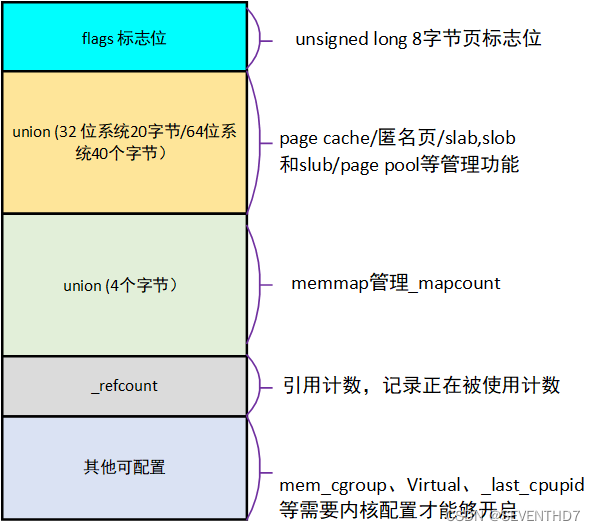
A.1#【内存管理】——1.1.3 page: struct page
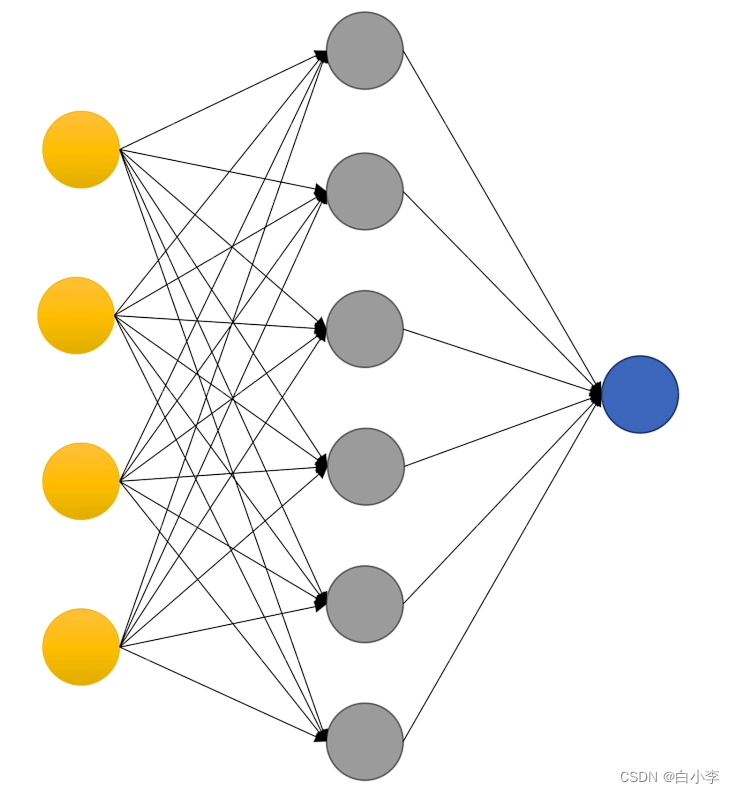
神经网络基础

2021-03-22
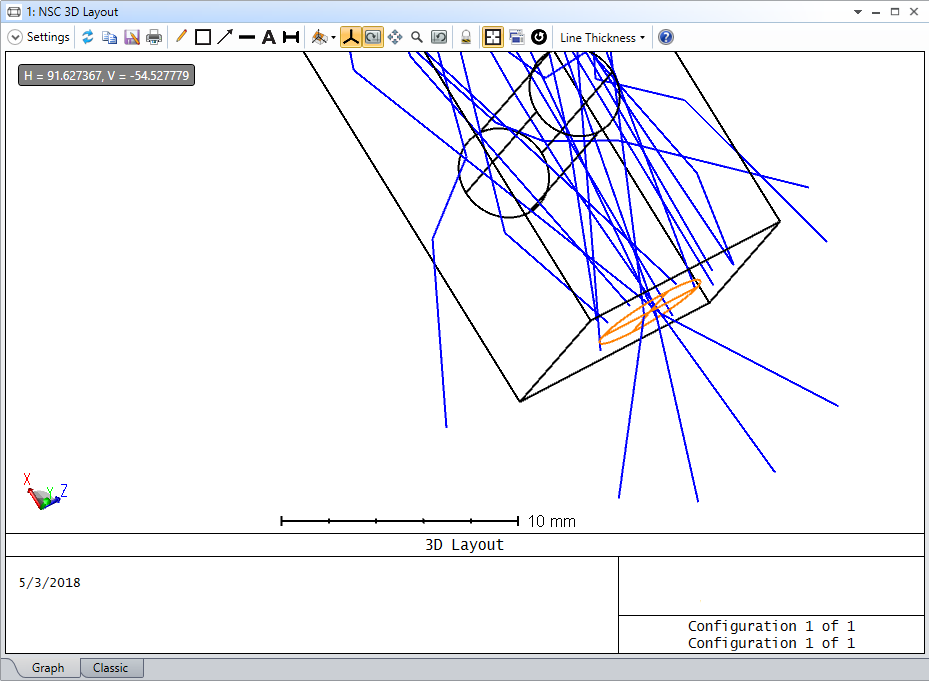
ZEMAX | 如何创建复杂的非序列物体

自监督论文阅读笔记 SimCLRV2 Big Self-Supervised Models are Strong Semi-Supervised Learners

交叉熵(第六周)

SolidWorks 操作视频 | 隐藏高手必备工具Defeature,让设计隐藏更彻底

block底层探索
随机推荐
深度学习理论课程第四、五章总结
window下VS2022封装动态库以及调用动态库
VCC(电源)和 GND(地)之间电容的作用
MATLAB自带的dwt2和wavedec2函数实现基于小波变换的自适应阈值图像边缘检测
g++参数说明
网络间通信
布尔盲注需简化代码
稳压二极管的工作原理及稳压二极管使用电路图
设备树解析源码分析<devicetree>-1.基础结构
cmdline -[command line,__fdt_pointer,initial_boot_params] boot_command_line 获取
建立平衡二叉树简单demo
二、Exception和Error有什么区别?
八、抽象类的接口的区别
Phase Vocoder的补充完善,Matlab音频变速不变调、变调不变速
2021-04-23
C# 数组之回溯法
最优化方法概述
ZEMAX | 如何围绕空间中的任何点旋转任何元素
自监督论文阅读笔记 Self-Supervised Deep Learning for Vehicle Detection in High-Resolution Satellite Imagery
6. What is the difference between Vector, ArrayList and LinkedList?(design, performance, safety)